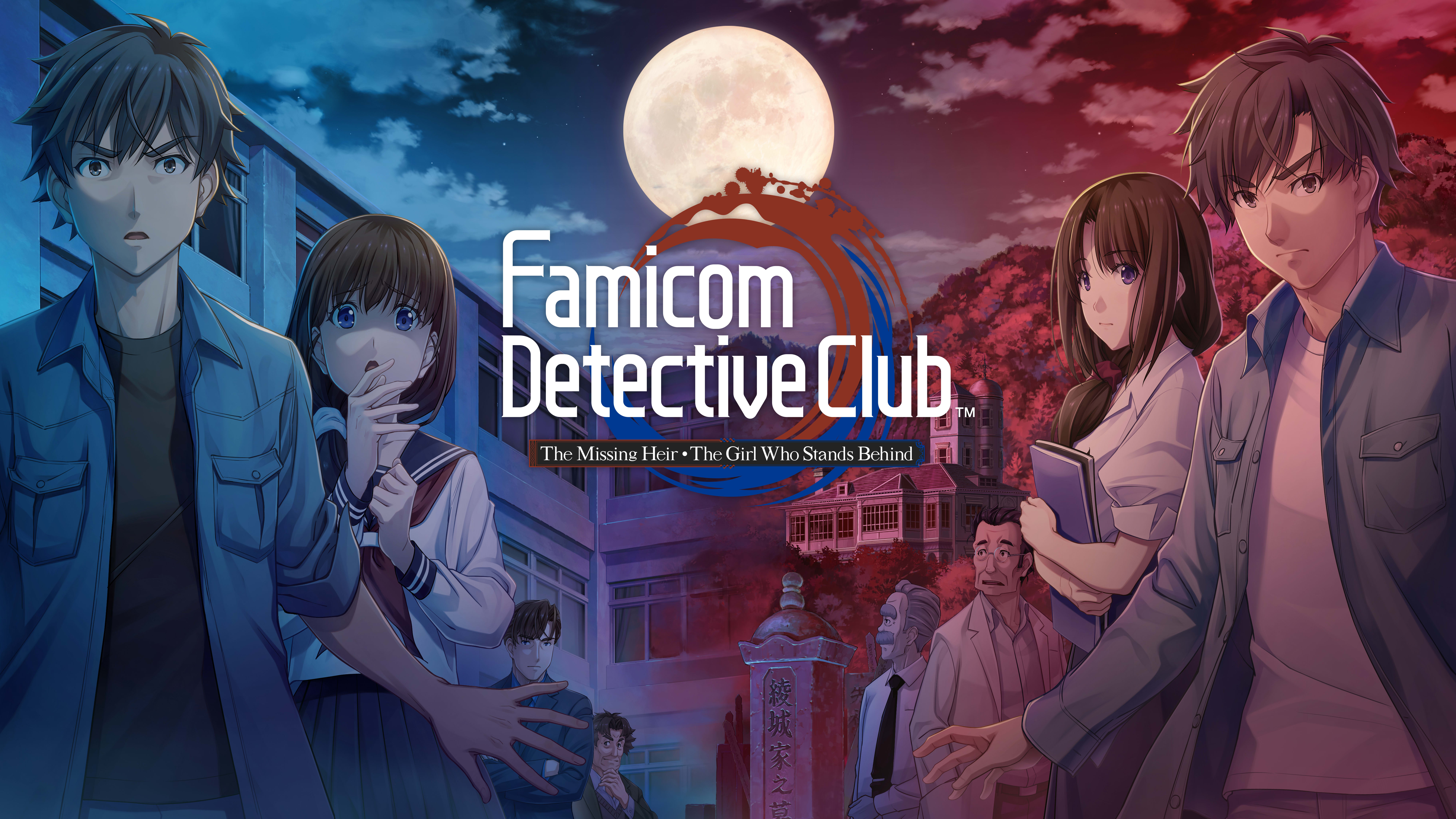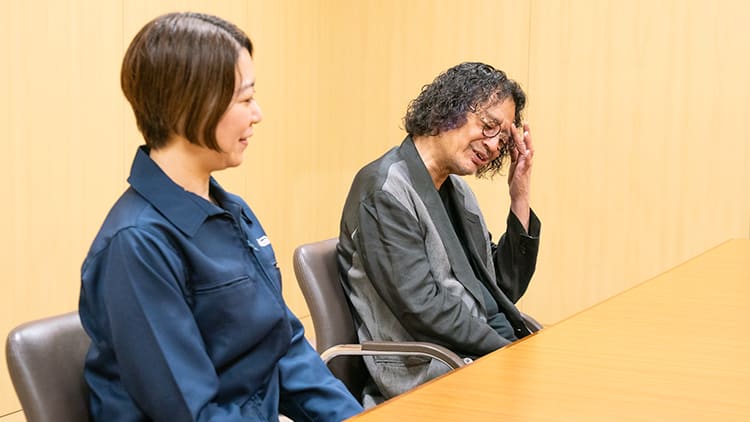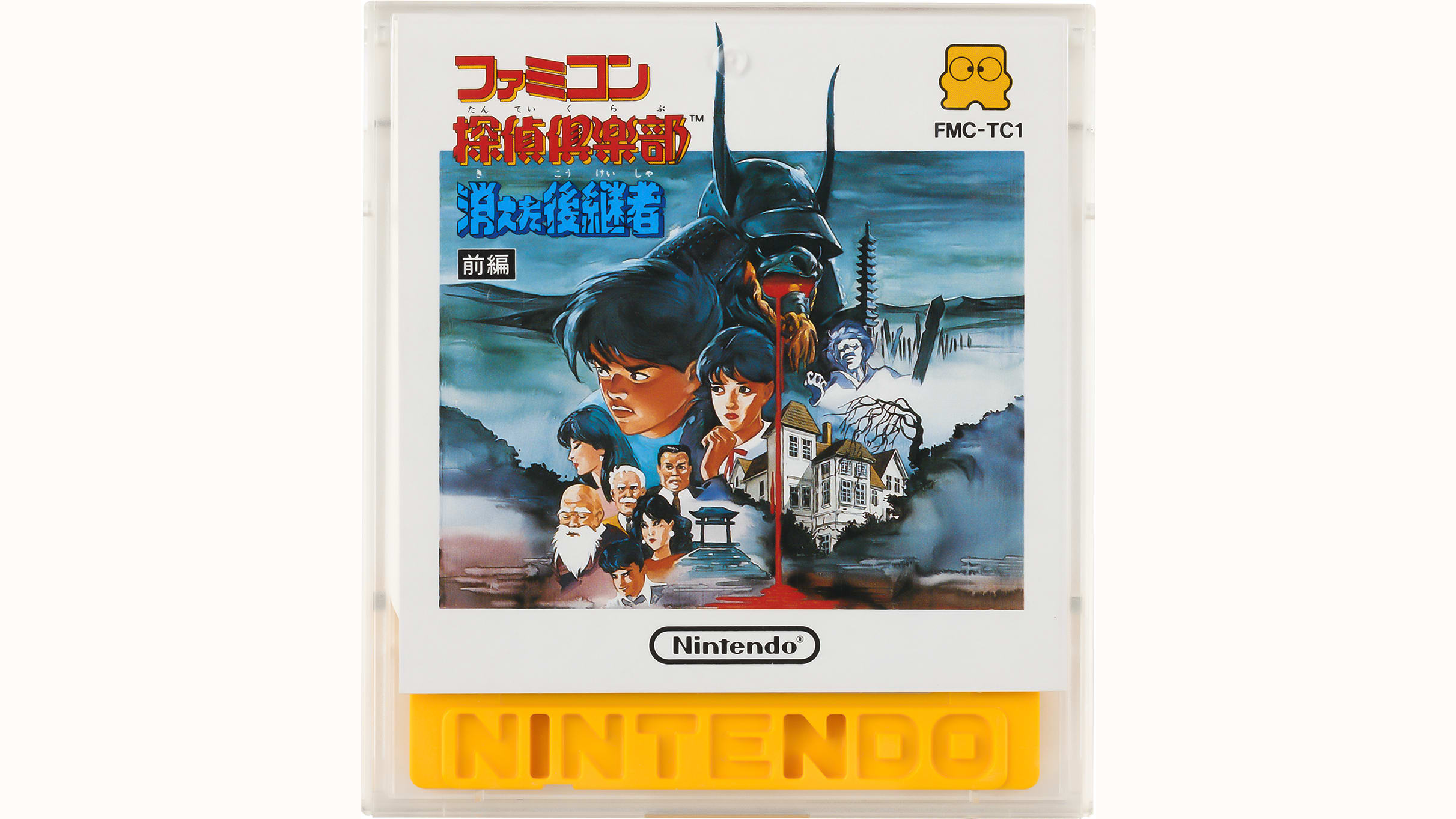
Ask the Developer Vol. 12, Emio – The Smiling Man: Famicom Detective Club—Part 1
This article has been translated from the original Japanese content.
Some of the images and videos shown in text were created during development.
In this twelfth volume of Ask the Developer, an interview series in which Nintendo developers convey in their own words Nintendo’s thoughts about creating products and the specific points they are particular about, we’re talking to the developers behind the Emio – The Smiling Man: Famicom Detective Club™ game for the Nintendo Switch™ system, which launches on Thursday, August 29.
Check out the rest of the interview
Part 1: What I really wanted to portray
First, could I ask you to briefly introduce yourselves?
Yoshio Sakamoto: Hi, I’m Yoshio Sakamoto. I've been involved in the development of various software since the Game & Watch™ era. From Family Computer and Family Computer Disk System to Nintendo Switch, I've led the development on a variety of games, including the Famicom Detective Club (1) series and Metroid™ (2) series. On the other side of the spectrum, I've also worked on two titles from the Tomodachi Life™ (3) series.
I personally like to get hands-on, so I worked together with Miyachi-san on this title, on everything from creating the plot to scriptwriting, considering and selecting background music to support the composers, as well as cutscenes and direction. That said, I’m credited as the game's producer again for this title. (Laughs)
(1) An adventure game series with two titles: Famicom Detective Club™: The Missing Heir, released in 1988; and Famicom Detective Club™ PART II: The Girl Who Stands Behind, originally released in 1989 in Japan for the Family Computer Disk System. Remakes for both titles were released for Nintendo Switch in May 2021 in Japan and other regions.
(2) An action game series, beginning with Metroid, which was released for the Family Computer Disk System in 1986 in Japan. The series is broadly split into two: the Metroid series, made up of side-scrolling action games, and the Metroid Prime™ series, made up of first-person adventure games.
(3) Tomodachi Collection, released in Japan for the Nintendo DS™ system in 2009, and Tomodachi Life™ released for the Nintendo 3DS™ system in 2013 in Japan (2014 in North America and Europe). Players place Mii™ characters that look like themselves, their family, or other people close to them on an island where time progresses at the same speed as in the real world, and watch over them as they go about their lives.
Kaori Miyachi: Hello, I’m Kaori Miyachi. I've been working mainly as a coordinator on games in a variety of genres, including the Donkey Kong Country™ Returns (4) game for the Wii™ system, Art Academy™ (5) for Nintendo DS, and Super Smash Bros.™ Ultimate (6) for Nintendo Switch. I also worked as a coordinator on various adjustments to the remakes of Famicom Detective Club™: The Missing Heir and Famicom Detective Club™: The Girl Who Stands Behind on the Nintendo Switch system.
(4) An action platforming game released for the Wii system in 2010. Players use a variety of Donkey Kong's actions such as pounding, grabbing, and rolling to overcome obstacles and defeat enemies to aim for the goal.
(5) Released in 2010. Using the Nintendo DS stylus, players can draw pictures as if using actual art materials such as pencils and paints. Through the lessons, players can learn tips on how to draw pictures of various themes, and they can also draw as they like.
(6) Released in 2018. A competitive action game in which characters from various games fight and try to blast the opponents off the screen. There are over 80 playable characters including the DLC, and more than 100 stages are available to battle upon.
Sakamoto:Then you met me and it all went downhill.
Everyone: (Laughs)
Miyachi: That’s not true! (Laughs)
For this title, I was involved as an assistant producer. My task was the same as Sakamoto-san's; I joined at the plot-development phase, eventually writing the script alongside him and coordinating the game's direction.
Thank you. Tell us, Sakamoto-san, what kind of series is Famicom Detective Club?
Sakamoto: Famicom Detective Club is a text-based adventure game first released for the Family Computer Disk System. You play from the perspective of the main character, a detective working at the Utsugi Detective Agency. In this series, the main character encounters mysterious cases and works together with his boss, Shunsuke Utsugi, and his colleague, Ayumi, to solve them.
The series is known for always incorporating some slightly scary elements in its stories. Well, it’s pretty much based on my own taste... Careful direction of the music, timing, and so forth was given to those scary elements.
Have you always liked adventure games, Sakamoto-san? Was there anything in particular that drew you towards adventure games?
Sakamoto: After Nintendo released the Family Computer, (Hiroshi) Yamauchi-san, the president at the time, made various requests to (Gunpei) Yokoi-san (7) asking him to develop this and that. And one of the requests was to come up with a game titled Famicom Shonen Tanteidan (Famicom Boys Detective Team).
(7) General Manager of the Research & Development 1 Department that existed at Nintendo at the time. During his career at Nintendo, he worked on many electronic toys, including the Ultra Machine and Light Gun series, and also led the development of products such as Game & Watch and the Game Boy™ system.
That's surprising. So the request for Famicom Shonen Tanteidan (Famicom Boys Detective Team) came first.
Sakamoto: Yes, and back then it was still called Shonen Tanteidan (Boys Detective Team). Yokoi-san shared with us the proposal made by an external development company that R&D1 was working with at the time. But, somehow, it didn’t quite feel like a game. And I thought this was no good.
Around the same time, an adventure game called Portopia Renzoku Satsujin Jiken (Portopia Serial Murder Case) (8) was released on the Family Computer. And when I tried it, it was really fun. You'd check suspicious places to discover something or look for a phone number. It made me realize that even those kinds of actions could be turned into gameplay, and inspired me to create something like this. So I went to Yokoi-san and suggested, “Why don’t we make a more solid adventure game?” Then Yokoi-san was like, “Fine, do whatever you want.” (Laughs) And that’s how I started working on it.
(8) An adventure game released in Japan by Enix (now Square Enix). A PC version was released in 1983 followed by the Family Computer version in 1985. With an assistant named Yasu, players investigate a serial murder case set in Kobe City.
By the way, did you have any plot-writing experience at the time?
Sakamoto: Believe it or not, I didn’t. But as a child, I read a lot. It might be hard to imagine now, but I was prone to being sick. (Laughs) I often missed school, and reading was about all I could do during that time. Maybe I was exposed to a lot of stories back then. However, I didn't have any writing experience, so my debut was with Famicom Detective Club.

Very interesting. It’s amazing that you were able to create Famicom Detective Club: The Missing Heir and Famicom Detective Club PART II: The Girl Who Stands Behind without any prior experience. Was there anything in particular you were striving towards when developing Famicom Detective Club?
Sakamoto: Well... I was really into movies back then. I particularly liked horror movies from an Italian film director named Dario Argento (9). I may have been influenced by him. However, the first game, Famicom Detective Club: The Missing Heir, was inspired by the concept of the Famicom Shonen Tanteidan (Famicom Boys Detective Team), and the idea of the protagonist having amnesia came from the external development team we were working with at the time. Because I wrote the plot based on those concepts, I never felt like it was the original story that I truly wanted to create. The end result was something that diverged slightly from my idea of "scary."
Still, I feel like I achieved what I set out to in terms of an adventure game that incorporates cinematic techniques. For example, asking myself, "How will it be if the music stops abruptly in this scene?" or "How about slowing down the pacing of the text during a tense scene?" As it turned out, lots of people enjoyed playing Famicom Detective Club: The Missing Heir, so I figured this type of game must have potential. That being so, I wanted to create my own world from scratch, which came out to be Famicom Detective Club PART II: The Girl Who Stands Behind.
(9) A film director who has worked on many horror films, including Suspiria.
So what you couldn't fully achieve in Famicom Detective Club: The Missing Heir, you incorporated into Famicom Detective Club PART II: The Girl Who Stands Behind?
Sakamoto: Exactly. And since many of the ghost stories that I fell in love with then are set in schools, I wanted to incorporate this theme. That said, there was a period of time when I wasn't making any progress with writing. (Laughs) I took inspiration from various movies I watched and thought were cool, and incorporated them into the game's direction.
One of the things that I was especially passionate about was the music. I planned on using music such as progressive rock (10) or technopop (11) from the 1970s. I was able to realize all of my ideas, and I was happy that it met my own expectations. And ultimately it was embraced by fans.
In retrospect, the development of Famicom Detective Club PART II: The Girl Who Stands Behind cemented what I wanted to do, and that enabled me to take on the challenge of this new title.
(10) A genre of rock music. It fuses different genres of music such as classical and jazz, and features complex musical composition that frequently uses irregular meter.
(11) A general term for pop music that is created with electronic devices such as synthesizers.
I see, so you were able to accomplish what you set out to and have a sense of closure.
Sakamoto: Taking into account the Family Computer's capabilities, I think the end result was decent. But one thing that caught my attention was the large number of people asking to have something like it every week. I was like, “That’s impossible.” (Laughs) I can’t churn out stories one after another, and while we discussed outsourcing it to an external writer, asking a novelist to write a story for the Famicom system is no easy request.
It’s not just about writing a story, because you also have to figure out what kind of gameplay it’s going to have. In the end, I was left to dwell on the fact that I couldn't release a new title and keep the series going.
Thirty-five years have passed since then, but has any conversation about Famicom Detective Club resurfaced during that time?
Sakamoto: Twenty-six years ago, I had a great opportunity to work on a remake of Famicom Detective Club PART II: The Girl Who Stands Behind for the Super Famicom.
Famicom was transitioning to Super Famicom at the time, providing more ways to express graphics and music, so I was excited to work on it. And I realized once again, "I really enjoy making Famicom Detective Club!"
But ultimately, no new story, no new game. On top of that, the opportunity for this remake came up by chance, and once I'd moved on to other games, it became difficult to think about Famicom Detective Club.
Twenty-three years later, it led to the remakes for Nintendo Switch. How did that come about?
Miyachi: The two remakes for Nintendo Switch were made possible thanks to MAGES., a game company that has produced a lot of adventure games. An employee from MAGES. pitched the idea to Nintendo with incredible passion.

Even during a different meeting between our point person for external developers and MAGES., they brought up the subject by saying, “By the way, we’ve updated the remakes proposal we talked about the other day!” and “We’ve also updated the video materials. Here's what we want to create!” and so on.
I heard those suggestions continued for more than a year. Seeing how serious they were, our staff started pitching their proposal and reference materials to internal teams, and that’s how it started.
Wow, that's passion right there! Why was MAGES. so excited about the remakes?
Miyachi: It seems like there was a staff member who was a huge fan of Famicom Detective Club.
Sakamoto: When I read the documents, I could feel MAGES.' enthusiasm, but I also wasn't sure how serious they were. Then I had a look at the graphics they created for the demo, and that’s when I realized that they really were serious about it.
Miyachi: They actually recreated a scene from Famicom Detective Club: The Missing Heir and brought it along to show us how they were planning to remake it, didn't they?
Sakamoto: Yes, the graphics featured animated characters from Famicom Detective Club, and the story was fully voiced. When we were working on the Family Computer version, those things obviously weren't possible, and this got me thinking, “Hey, this might be it–we could make a new Famicom Detective Club!”
So you felt confident after seeing something tangible. By the way, Miyachi-san, have you played a lot of adventure games (12)?
Miyachi: No, never before I joined the company... Personally, I like RPG games where you level up bit by bit, but after I started working here, I thought to myself, “I'd better give it a go first before passing any judgment,” so I played a whole bunch of games across a wide range of genres. Some of these were adventure games, and I was introduced to a world of gaming I'd never experienced before.
As for Famicom Detective Club, I'd heard of it but hadn't had the chance to play it. When I was assigned as the lead for the MAGES. remakes, my first task was to complete Famicom Detective Club PART II: The Girl Who Stands Behind on Nintendo 3DS Virtual Console. (Laughs) Once I'd actually played it, I was blown away. I honestly wondered, “Why haven’t I played this before?!”
(12) A game genre in which the player progresses through the story from the protagonist’s perspective, choosing their lines and actions at various branching points. Also called a "text adventure game."
I see. The start of the remakes' development was your first experience with Famicom Detective Club. And so, the two of you took on a central role in the development of the remakes.
Sakamoto: At first, I intended to join in a supervisory role. You know, just reviewing what MAGES. created. But MAGES. said to me “Sakamoto-san, let’s work on this together!” So I was like, “Really? Can I join too?” (Laughs)
As much as I like to get hands-on, I wasn't sure how far I could stick my nose into the project or whether I could join in, since it was MAGES.' idea. Then Miyachi-san said to me, “Just join in!” (Laughs)
Miyachi: I'd say he was a bit reserved in the beginning. He'd say things like, “But I’m a supervisor, so I should just review it, right?" or “Is it okay if I share my opinion?” so I gave him a push and told him, “Just say what's on your mind!” (Laughs)
Sakamoto: So I actually joined in and didn't hesitate to share my thoughts. By the end, I was so heavily involved that I wondered what had happened to my so-called "supervisor" role. I’m really grateful to MAGES. for accepting my opinions and giving them form.

The two remakes were released in 2021, but was there anything you gained through their development?
Sakamoto: I guess by working on the remakes, I could feel Famicom Detective Club's potential to become what I really wanted to portray, and that I could achieve it. Also, I felt like I'd found the people I'd definitely want to work together with again, if there ever were a "next time." Namely MAGES., to cooperate with development, and Miyachi-san! I already had them locked in. (Laughs)
Miyachi: For me, it was a great opportunity to get to know MAGES., but more than anything, being able to work side-by-side with Sakamoto-san, who's created a lot of things at Nintendo, was really huge. I learned a lot about Nintendo's unique way of creating products, its perspective and philosophy.
Read more in Part 2: A fresh new Famicom Detective Club


